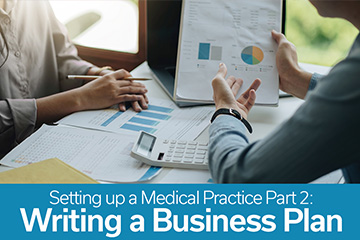
Setting Up a Medical Practice Part 2: Writing a Business Plan
Catch up on Part 1 before starting Part 2!
Business plans are one of the most important strategic tools for any aspiring business owners, including physicians who are seeking to own a medical practice. Quite often, business loans from the bank are contingent on the approval of business plans.
To be successful in opening your own medical practice you would need a roadmap. Some benefits of creating a strategic plan include improving the quality of patient care through having clear objectives, creating clear direction for marketing initiatives, allowing all stakeholders to collaborate, and better understanding the competitive landscape.
Before building your business and treating patients, check out our list of give essentials.
1. Make Sure all Credentials and Licensing are in Place
During the credentialing process, you’ll have to present insurers with a valid medical license and possibly malpractice insurance.
This process of filling out paperwork may take several months to complete. Based on the location and type of practice you are opening, the specific requirements may vary. You’ll have to do your own research to find everything you need, including credentialing and hospital privileges, insurance, and license & membership fees based on your province of practice.
2. Outline your Medical Practice Goals
The most exciting part of opening a medical practice is creating a vision and setting parameters for how to build a prosperous and profitable medical practice. Some questions you’ll want to ask yourself are how many patients do you anticipate per day or week? What will your income look like weekly? How many support staff and doctors will you need to hire?
To help you answer these questions, you’ll have to do some preliminary research of existing clinics that are similar to your own within your catchment area.You should also learn about the overall health profile in your geographical location.
3. Be Strategic with your Finances
What will be the cost to get your practice up and running? What are your expenses compared to your prospective income? What does it take to create a profitable business?
To answer these questions, you’ll have to calculate all your expenses including technology, furniture, medical equipment, staff salaries, licensing fees and practice management software, monthly rent, and medical insurance.
4. Research and Study your Marketplace
To provide top-quality patient care, you must study the local, national, and international level of the marketplace and you will have to adapt to new trends in healthcare.
The growth of the infrastructure and technological upgrades and advancements in healthcare will continue to increase and patients are adapting by seeking out virtual healthcare. In a competitive marketplace, doctors must find their unique selling point and highlight the demand to make their practice stand out.
5. Understand who your Ideal Patient is
A specific niche in healthcare, rather than offering a broad range of services, can allow a medical practice to offer higher quality of focused patient care and can be more cost-effective. Once you have chosen a niche for your practice, create an ideal patient profile:
-Who they are
-Their age
-Their location
-Their income
-Type of services they expect
A patient profile will ensure you are always talking directly to your ideal patients and will assist in targeting your marketing efforts.





